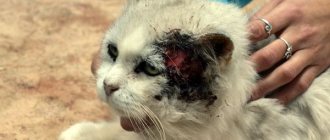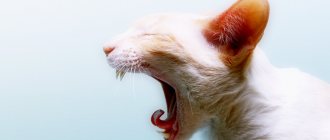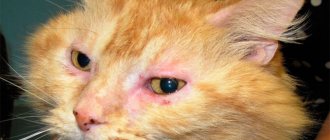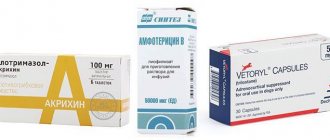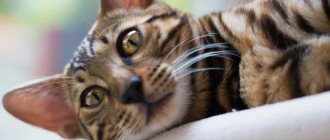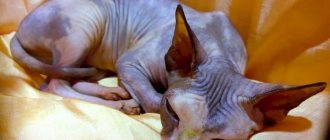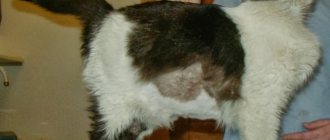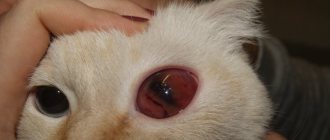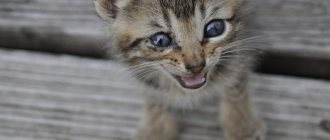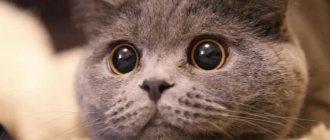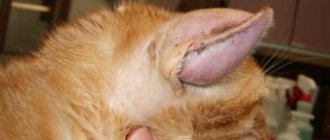There is a disease the outcome of which even an experienced veterinarian cannot predict. With panleukopenia, occurs in cats , which is accompanied by neutropenia . These terrible diseases are interconnected and it is worth taking a closer look at the causes, symptoms and treatment methods.
Looking ahead, it is worth saying that with this disease, leukopenia, and at the first symptoms, you should urgently contact an experienced veterinarian
, who has already encountered a similar disease and symptoms. Owners conducting diagnostics and treatment risk endangering the life and health of their pet. After all, treatment is selected on the Internet, without taking into account the specifics of the disease and the animal’s body.
Only a veterinarian is able to identify and correctly diagnose the deviation and prescribe treatment, according to the individual specifics of the cat’s body. After the call, the expert arrives within an hour thanks to veterinary center locations in the city and suburbs. Over the phone, the owner will be told the price they pay for leaving and it will not change. The doctor himself also asks questions over the phone. Answers to questions help form an opinion about the diagnosis even at the entrance. This will shorten the examination time and help prescribe treatment. After all, in such diseases, time plays a key role that cannot be wasted.
Leukopenia in cats and panleukopenia - what is it?
Leukopenia in cats is a disease in which the number of leukocytes in the blood decreases to critical limits. And it’s not for nothing that immunity-boosting products . It is because of deficiencies in minerals and certain vitamins that deviations from the norm occur and the disease develops.
If we talk about a stable and positive number of leukocytes in the blood, then in cats it is 5.5-18.0 * 109/l. The quantity can be either reduced or increased. If there are a lot of leukocytes, then an inflammatory reaction occurs in the body. It is not very difficult to treat such deviations; a qualified veterinarian will quickly get the cat back on its feet and return the leukocytes to the desired state. But a low content has a much more negative effect on the body, and the decrease occurs against the background of many unpleasant diseases, the symptoms and treatment of which are specific and depend on each pet individually. This is the difficulty, because diagnosis becomes not so simple. White blood cells decrease during sepsis.
However, leukopenia is a temporary phenomenon
, arising as a background infection.
Cells die and accumulation occurs at the site of infection. The dangerous case is when it would seem that treatment has been undertaken, but the number of leukocytes does not increase, being in a very dangerous range. This often occurs in veterinary practice.
Panleukopenia - what's the difference?
It is worth saying about panleukopenia
, and then, in subsequent sections, both diseases will be addressed simultaneously.
After all, panleukopenia in cats is a disease in which the number of leukocytes decreases, but at the same time gastrointestinal disease occurs. The disease has a number of other names such as infectious gastroenteritis, parvovirus enteritis, feline distemper and typhus.
If we talk about the virus and the danger to humans, the disease is not dangerous. The disease is not dangerous for people. The disease itself appears during the birth of kittens, or rather in the spring and early summer. This is dangerous because there is a risk of death for newly born cats. However, it is worth remembering that the disease can appear between the ages of six months and 8 years; the disease does not always depend on specific causes. Sometimes it appears unexpectedly.
Chemical analysis of urine
During a general analysis of urine, a chemical study of its composition is also carried out. At the same time, most of the components in the urine that can indicate the appearance of any diseases in the cat are checked. First of all, urine is examined for the presence of the following substances:
- Protein
- it is usually not found in the urine of a healthy animal, although its presence is allowed in amounts up to 0.3 g / liter of liquid. The appearance of more protein accompanies pathogenic processes. An accurate diagnosis can only be made after additional research. The list of possible diseases is long - it could be any infection, pyelonephritis, urolithiasis, urethritis, pyometry, cystitis; - Glucose
- the presence of this carbohydrate is not detected in healthy animals. Its appearance usually indicates that the cat has diabetes. However, it is sometimes also found in renal failure and even in stressful situations. Glucose may appear when there is an excess of carbohydrates in the pet’s diet and treatment with certain medications; - Ketone (acetone) bodies
- this component is absent if the cat is healthy. When detected together with glucose, it marks the cat as having diabetes mellitus. If glucose is absent, then a possible reason for the appearance of ketone bodies may be prolonged fasting, poisoning, severe fever, and even long-term eating of fatty foods; - Bilirubin
is a bile pigment. The appearance of bilirubin in the urine indicates problems in the liver or blockage of the bile ducts. May signal hemolytic jaundice; - Blood and hemoglobin
are a signal from the animal’s body about the presence of a serious pathology of internal organs. The appearance of blood in the urine is a sign of injury to the urinary tract or bladder, nephritis, and even the development of a tumor. A change in urine color to coffee indicates the presence of hemoglobin, which is typical for infections, burns and poisoning.
Leukopenia in cats - causes of the disease
The cause of the disease is considered to be paroviruses , the DNA of which contains a virus close to the enteritis of dogs and minks. The size of the virus is incredibly small, about 20 nanometers, it looks like a small capsule. It exists in this capsule for about a year at almost any temperature. It feels especially comfortable in organs, animal feces and cells.
The virus is difficult to kill even when heated above 60°C
.
In this state, the virus can live for an hour; disinfection is not a 100 percent guarantee. Only chlorination can cope
with the virus is resistant to other methods of disinfection.
Typically, one part chlorine and thirty parts water are used to clean a room. If the virus gets on the cat’s clothes or other objects
(toys, bedding), then throw it away, and the best idea would be to burn these things to avoid re-infection of this pet or primary infection of another.
The disease is considered very dangerous; it is not for nothing that it is called “ cat plague ”. The disease itself is dangerous, both for cats and, in principle, for the entire cat family, which includes tigers, lions, pumas, leopards, cheetahs, and so on. The virus spoils the gastrointestinal tract, endangering the heart muscle, as well as the lungs and bronchi.
Treating the virus is difficult and takes a long time; even an experienced veterinarian can hardly help and certainly does not guarantee a favorable outcome. However, if the disease is detected in time during a general diagnosis or by symptoms and signs, which we will talk about later, then thanks to an integrated approach and professional treatment there is a chance to avoid death. However, this is only in case of emergency, otherwise death is inevitable.
Leukopenia is an incredibly persistent disease and difficult to treat. However, with timely diagnosis and comprehensive therapy, the disease soon recedes, allowing the animal to live a full and free life. Panleukopenia in cats has the status of a fatal disease. Therefore, when detected, the pet requires urgent and emergency help , because the probability of mortality reaches 90%
.
Epidemiology
The feline distemper virus does not have an envelope and is highly resistant to physical factors and chemicals. In a contaminated environment, it can remain infectious for weeks or even months. Diseased carnivores secrete the virus in high titers and the virus quickly accumulates in places where cats are kept, for example, in catteries. Because the virus is highly contagious, susceptible animals can become infected even after seemingly thorough disinfection of premises.
It is therefore recommended that only successfully vaccinated kittens and cats be allowed into such an environment. Although there is little data on the prevalence of panleukopenia virus, nurseries and shelters are particularly susceptible to proliferation. After intrauterine infection, the virus that causes the feline disease panleukopenia is present in the cerebellum of kittens for several weeks.
Leukopenia in cats - methods of infection
itself is transmitted orally
from other infected cats and kittens. The disease is excreted in urine, feces, vomit and saliva, and there are cases of infection through fleas. The virus gets into the water, food, bedding or bowl of the cat, from where the animal becomes infected and subsequent problems with the body occur.
After the pathogen enters the body
rapid reproduction
occurs , as well as spread throughout the animal’s body.
At this time, there is a so-called incubation period
, which takes
from two to ten days
.
The virus multiplies and kills cells in the body, this applies to the bone marrow, gastrointestinal tract and blood. Anemia appears , depriving the protective barrier from other viruses or bacteria. Infection occurs a second time
, which makes treatment even more difficult than it would have been before. This is especially true for younger individuals and very young kittens, whose bodies have not yet developed protective barriers, and with failures due to steam viruses, the situation becomes even more deplorable.
Neutrophils and lymphocytes main functions
Thanks to the active activity of leukocytes, the body is reliably protected from various infections. A leukocyte is a cell that has no color. It consists of enzymes whose task is to absorb pathogenic microorganisms and destroy decay products.
As for neutrophils and lymphocytes, these are types of leukocytes that perform essential functions. And if their number decreases, then the person will have to seek medical help.
The largest group of leukocytes are neutrophils. With their help, the body gets rid of bacterial and fungal infections. The place of cell formation is the bone marrow.
There are two stages in the process of their formation:
- Early, that is, band-nucleus (there is no fully formed nucleus yet).
- Mature, segmented.
The final maturation of rod cells occurs in the bloodstream. You can observe the appearance of 3-5 segments in the nucleus, which are connected by jumpers. Thanks to this structure, leukocytes can penetrate into tissues. Mature neutrophils have “feet”.
A mature neutrophil, entering various organs, begins to come into contact with foreign microorganisms; it envelops the foreign body and destroys it. Unfortunately, segmented cells are practically powerless against viruses. But they deal with bacteria very well.
The neutrophil also dies along with the microorganism. But he manages to send a signal to other leukocytes, releasing a special substance. If you take pus, which is the result of a fight between cells and bacteria, for analysis, you can find a large percentage of leukocytes that died in the “battle.”
Lymphocytes have an equally important role.
They recognize and subsequently destroy:
- pathogens of infectious diseases;
- fungi;
- tumor cells.
First, lymphocytes are synthesized in the bone marrow, and from there they enter directly into the bloodstream.
How is leukopenia diagnosed in cats?
The diagnosis of leukopenia in cats is made after a thorough and detailed examination of the pet by a veterinarian, he conducts express tests and applies the information obtained to the future course of treatment and diagnosis. It is very important to monitor the clinical manifestations of the disease. The veterinarian will ask a series of relevant questions to the owner to avoid making mistakes in the future. The animal's medical history must be asked. This is very important, because the disease hides under the mask of an existing disease. Knowing what your cat was sick with will help you avoid mistakes in making a diagnosis. It is for this reason that in no case should diagnosis be allowed, much less treatment on one’s own, at home using folk methods. After all, diseases of different severity may have the same symptoms and signs.
. This increases the risk of misidentification of the disease.
Leukopenia in cats and panleukopenia. How does infection manifest itself?
Both diseases behave differently in terms of symptoms. Sometimes they resemble symptoms of other diseases that are less severe and are subject to easy treatment methods. However, if the treatment is mixed up, that very precious time will be lost.
, which had to be spent on illness. Panleukopenia and leukopenia have two types of disease progression: mild and severe. Mild symptoms include mild loss of appetite and a slight increase in temperature. Adult and healthy cats, whose body is able to fight against the virus, are susceptible to such symptoms.
If we are talking about kittens or old cats
, then the immune system has either weakened or not formed to the stage to resist infections and viruses from the outside. Thus, in such cats the disease is extremely severe, the symptoms themselves appear unexpectedly, and development occurs faster than in a mild case. This especially happens if the disease is not treated or detected too late.
Symptoms of leukopenia in cats
- Symptoms that appear in cats during illness:
- Lethargy.
- Fatigue.
- Loss of appetite and desire to drink water.
- The general temperature in the body reaches forty degrees or jumps even higher.
- Vomiting, the masses of which have a watery base with a brown or yellow color. In especially severe cases, mucus and blood clots appear.
- Fever.
- Severe bloating and enlargement of the abdomen.
- The nose becomes dry, which is not so difficult to notice.
- Red, painful spots become visible on the skin.
- Difficult and heavy breathing begins.
- Diarrhea and diarrhea. The stool itself is yellow, sometimes blood and fibrin appear there in the form of impurities and clots.
- Due to the fact that the pet experiences severe pain in the groin and peritoneum, they hide in secluded places; the animal is often found in dark corners where no one bothers the animal. There is a possibility that the animal will behave aggressively if you try to touch it. This is due to pain and reluctance to communicate.
- The animal is not able to eat normally, so the cat is found next to the bowl in a hunched state. They try to eat the food, but immediately after the first bite they start vomiting, so they seem to have no appetite. In fact, animals are not able to eat food or drink water.
The above symptoms and signs show the simple fact that inflammation of the gastrointestinal tract of the catarrhal form or hemorrhagic sign occurs. They develop the virus.
Course of the disease leukopenia in cats
The disease leukopenia has a particularly acute course
, which has been said to appear
in very young kittens . Their nervous system is damaged , the animal becomes especially timid, mobility increases, it becomes too active, but at the same time does not want to play. He is active but restless. Like adult cats, kittens experience vomiting and diarrhea. Paralysis and paresis of animal limbs and some organs occurs. The disease develops extremely quickly, because the body is not able to resist. If treatment is not started as soon as possible after infection, then death is guaranteed and nothing can be done about it
.
The disease can enter the kitten’s body through the womb.
when the mother herself becomes infected or was sick during mating. Outwardly this does not manifest itself in any way, but after a while signs of the disease and symptoms begin to appear. This can be seen in the pet’s movement, loss of coordination, and awkward movements. It is impossible to cure such a pathology; the cat will go through such problems throughout its life. Only treatment of the mother herself, and in a timely manner, can eliminate the consequences. In the offspring, the virus will get too deep into the genes and body.
Leukopenia in cats and the severity depends on
the pet’s age, immunity status and health before the disease. If we talk about adult individuals, then they themselves get rid of the disease, plus they develop immunity against this particular virus for the rest of their lives. If these are kittens, then immunity will not be developed, and if the treatment is successful, then there is a chance of recurrent disease. In kittens, the incubation period lasts about a week, during which time it is impossible to notice. If by some miracle the disease is not detected, then within a week the active development of the virus will begin and death will not be long in coming. Death occurs from general exhaustion, dehydration and conquest of the whole body by the virus.
To summarize, it is important to note that leukopenia in cats is detected in the first stages , because the animal becomes unnaturally lethargic and apathetic to everything. Cats are not typically in such a mood, so at the first suspicion of illness, you should immediately call a doctor. At the veterinary, experienced experts arrive within one hour. Quick diagnosis and express tests will help you quickly determine whether it is indeed leukopenia or panleukopenia and prescribe a course of treatment according to the individual characteristics of the body.
If the pet is over six years old
, then you should pay attention to such symptoms. After all, in addition to kittens, older cats, old-timers get sick, weaken and are no longer physically able to fight the virus.
Leukopenia in cats. Signs of infection in kittens
Since the disease has even greater risks and likelihood of death for kittens, it is worth considering their symptoms separately. Knowing the signs, the owner is able to call a veterinarian at the first suspicion of illness.
So, the main signs of leukopenia in kittens :
- The kitten does not want to take mother's milk and refuses it.
- Anxiety increases, the squeaking does not stop. The kitten looks worried.
- Doesn't move and lies motionless.
- He can't sleep because he has pain in his abdomen and groin area.
- Paralysis of the kitten's paws occurs.
- Body temperature rises.
- Convulsions occur.
However, unfortunately, it sometimes happens that kittens die without symptoms. It would seem that they felt fine and looked healthy, but death came unexpectedly.
It is worth giving the kitten a vaccine, but not immediately after birth. The disease develops between three and seven months of age. This is the time when immunity has not yet formed. This means that the vaccine should be taken around the beginning of a possible disease or a little earlier. Each kitten has its own individual characteristics, which the veterinarian takes into account.
Symptoms
If there are low leukocytes in a cat’s blood, this always affects the state of the immune system. The animal begins to get sick often, especially with colds. Complications such as pneumonia and bronchitis often develop.
With leukopenia, your pet often experiences gastrointestinal disorders. Even with proper nutrition and good care, the cat often suffers from vomiting and diarrhea.
The gums and oral cavity become inflamed. Because of this, the animal often refuses to eat. The pet is losing weight quickly. Inflammation of the eyes with purulent discharge appears. At the same time, the cat’s fur loses its shine and looks matted and unkempt. The skin is prone to inflammation.
If the owner discovers such symptoms in his pet, then he needs to take the cat to the veterinarian and do a blood test. It is possible that these phenomena are associated with leukopenia.
Often, the symptoms of panleukopenia in cats can resemble manifestations of other diseases.
The pet becomes drowsy, lethargic, and stops eating. Vomiting appears, at first watery, with brownish or yellow foam, then mucus and blood may appear in the vomit.
Feline distemper is accompanied by fever (up to 41 °C and above) and diarrhea. Feces have a yellowish tint, a very unpleasant smell, and sometimes there is blood in them. The cat has a stomach ache, stands arched, or tries to hide in a dark place.
The mucous membranes become dry, the eyes stop shining. The skin becomes inelastic and slowly flattens out when folded. These signs indicate dehydration, which develops against the background of vomiting and diarrhea.
In small kittens, symptoms of panleukopenia may be absent, especially in the fulminant form of the disease. In other forms, the infection can be identified by the following signs:
- refusal of milk;
- lack of sleep;
- complete immobility or restless behavior accompanied by constant squeaking.
In older kittens (aged 3-7 months) and adults, panleukopenia is manifested by the following symptoms:
- restlessness, lack of sleep;
- refusal to eat and drink;
- vomit;
- diarrhea;
- heat;
- convulsions;
- paralysis of limbs.
The nature of the course of the disease depends on the age of the pet and the state of its immunity. In adult cats, the infection is less severe.
If you suspect feline distemper, you should immediately contact a veterinarian. You need to transport your pet very carefully. Place her in a carrier with soft bedding. On the road, try to avoid sudden movements, this will bring additional suffering to the cat.
Treatment of leukopenia in cats
Only an experienced veterinarian can prescribe the correct treatment for the disease. Any treatment begins with an examination of the animal.
and diagnosis using rapid tests and routine examination. Plus questions to the owner about the medical history.
Popular remedies used in treatment come down to antibiotics. Duration of use and dosage are a whole science, so leave it to a professional! After all, even allergies can greatly worsen your health.
Rules for caring for a pet with leukopenia in cats
It is important to take care of your cat during treatment. Thanks to care, the disease will not only recede faster, but will definitely help eliminate it. For any living being, love and attention are the best medicine and medicine
.
- Below we will tell you the main tips on how to care for your animal while leukopenia occurs in cats:
- When sick, a cat should be in a heated room with dry climate and air. Sometimes it is worth letting a draft into the room, but at this time the animal is transferred to another room for literally ten minutes.
- Immediately after going to the toilet, the tray is removed so that the virus and harmful substances leaving the body do not continue to harm health. Discharges from the body can trigger a recurrence of the disease or even intensify the current disease.
- If something comes out of your pet’s eyes and nose, then it is worth cleaning it with the help of the solutions recommended by the doctor.
- It is imperative to maintain hygiene of everything: the owner’s hands, disinfection of the room, bowls, bedding, and so on. Remember that only prolonged washing or bleach can kill the virus.
- If the animal refuses to eat, then you should not insist and force feed. It is worth leaving small portions in a bowl and waiting for the animal to eat on its own. If food sits for longer than an hour, it is worth replacing to prevent other infections from contaminating the food.
- Follow the diet prescribed by the veterinarian. They contain heavy dairy products and should not be consumed. You should eat cottage cheese, low-fat broths, rice porridge, cooked chicken or beef, and so on. Only after the animal becomes stronger is it given fish, fermented baked milk and other products. You should not choose the product you feed your cat. This is determined by an experienced veterinarian.
- To prevent the animal from wasting energy, it is worth placing important things in a favorite place. Place toys, bedding, a bowl, etc. nearby - what the animal needs every day.
- During treatment, you should not make noise or frighten the animal. Don't turn on the TV loudly, slam doors, talk on the phone, and it's better not to let guests in. After all, cats get very scared from this.
- It is worthwhile to communicate affectionately with the animal, talk to it, stroke it and behave caringly and lovingly. Take care of your pet, show love and affection.
If there are other felines living at home, it is worth taking it to the veterinarian. Only after a detailed diagnosis and examination for the presence of the virus is the owner able to breathe out calmly. If they are healthy, they are moved out of the premises and apartment for at least a month so as not to run the risk of contracting the disease.
Is it possible to cure the disease?
It is impossible to answer this question unequivocally. First you need to find out what caused the drop in nuclear-free formed elements in the blood. Based on this, treatment is prescribed. In some cases, it is generally enough to eliminate the source of stress (ill-mannered children, aggressive dogs, larger and more aggressive cats) or stop taking medications.
In other cases, doctors prescribe polyvalent serums, antivirals and antibiotics.
When bone marrow diseases are detected, even the best treatment can only slightly weaken the disease, delaying the inevitable end.
Leukopenia in cats - disease prevention
Care during illness is important, but attention is also paid to prevention After such an illness – even more so. Care on the part of the owner is important in this situation, otherwise there is a chance of losing the animal due to stupidity. After all, the disease stays in the body for a long time
and the owner takes care that after treatment and the vaccine the disease does not recur, which sometimes happens, especially without proper observation and control of the course of recovery.
Vaccination against leukopenia in cats
Of course, every veterinarian will say that a vaccine is not considered a one hundred percent guarantee that the animal will recover. But the vaccine develops the body, makes it resistant to diseases , and increases immunity. If an animal becomes infected, the body often copes with treatment much faster and more effectively than any synthetic veterinary drug.
Vaccine injections are given to pets at an early age
, most often from three months after the birth of a kitten. Even if the owner is sure that the cat will live in the apartment (will not leave the premises), the vaccine is given. After all, there is a possibility of bringing the virus on your hands or clothes. It can appear on the bowl or remain on the bedding, and then the virus will definitely take over the cat’s body, but it will not be able to resist on its own, which means the likelihood of death will increase. And the vaccination procedure and injection itself are much cheaper than a full course of treatment for panleukopenia, the same thing with time.
The Ya-Vet veterinarian is ready to advise on vaccination and do it at the appropriate time around the clock. After the call, he will arrive in exactly one hour and perform the operation. However, it is worth remembering that before vaccinating, you should make sure that the animal is healthy. The doctor will definitely do this upon arrival. Vaccination is carried out at any age, but if the cat is pregnant, then the procedure should not be carried out, just as it is not worth it in case of individual deviations or any other pathological health problems.
Conditions for keeping a pet for the prevention of leukopenia in cats
For any disease, prevention is the best cure.
- Be sure to comply with the following conditions for keeping your pet:
- Inject vaccines into animals.
- Mandatory quarantine and inspection of all untested animals. New ones in the family - quarantine. Neighbor or anyone else - check.
- Healthy eating, diet and properly selected food. A veterinary nutritionist at Ya-Vet will help you figure this out.
- Mandatory sterility and hygiene in the apartment. It is worth regularly washing and washing bedding, bowls and everything that your pet interacts with. The owner himself should wash his hands.
- If the animal is already sick, then it must be immediately isolated and protected from communication and communication with other cats.
Prevention according to these points will help avoid infection and reduce the risk. If the animal has just recovered
, then you should ensure that the symptoms do not recur and the animal no longer experiences discomfort.
